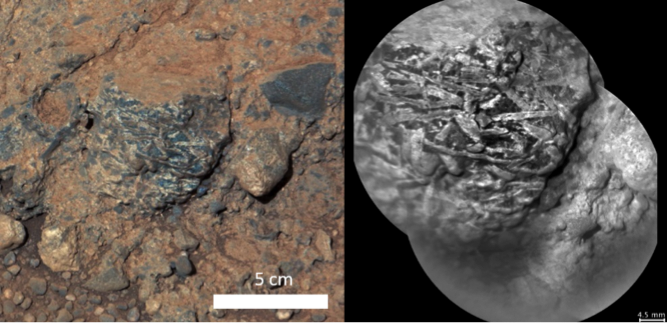Research

We study the “source-to-sink” sedimentary rock system on Mars using clastic sedimentology, geochemistry, mineralogy, and remote sensing. We are interested in all aspects of the cycle, including the igneous provenances that sourced sediment, the paleoenvironments that weathered sediment, sediment transport and sorting processes, deposition and lithification, and finally diagenesis and alteration, including fracturing and fracture fills. We develop our understanding of this cycle using terrestrial analogs and geochemical models that enable us to describe past environments on Mars. We are also interested in utilizing drones and cutting-edge visualization techniques to enhance our understanding of both planets.
Much of our current research is motivated by observations from the Curiosity rover, which is driving across sedimentary strata in Gale crater. The sedimentary rocks there were delivered into the crater by rivers and wind ~3.5 billion years ago and were exposed by wind erosion.
Current Projects
MIST Algorithm

Identifying minerals is a prerequisite to interpreting geologic history from samples. Various techniques for mineral identification are available, but one method commonly used for individual grains or crystals in a sample is to obtain high-resolution geochemical information of the grain and compare element ratios to known minerals, i.e., stoichiometry.
We developed MIST (Mineral Identification by Stoichiometry) as a first-principles-based computational algorithm to identify geochemical observations with stoichiometric elemental ratios that match real-world compositions. Identifying minerals by stoichiometry works when the geochemical measurement spot size is smaller than the size of the mineral. Beyond this requirement, stoichiometric rules are agnostic to the source of geochemical data. MIST uses normalized oxide weight percentages and stoichiometric ratios between elements in a detailed decision tree approach to identify mineral phases using recognized mineral group hierarchies. The approach incorporates tolerances tailored to the imperfections and elemental substitutions common in real-world minerals. When an observation matches a mineral species, we output the name of the mineral according to IMA rules and a detailed stoichiometric mineral formula. The algorithm has been tested on well over 2000 mineral compositions and currently identifies 250 mineral species with >95% accuracy. MIST is free to use via an online API at mist.rice.edu.
Source Rocks

Valerie and Kirsten are identifying and studying igneous minerals within sedimentary rocks of the ancient fluvial rocks of the Bradbury group. The chemistry of the igneous minerals that have not been significantly weathered is used to constrain models of the volcanic systems that were upstream when the rocks formed. This work has indicated that at least two upwelling magmas experienced fractional crystallization to produce the minerals found in the Bradbury group.
Weathering

Michael and Kirsten are studying weathering of basaltic volcanic rocks in rivers in Iceland and around the world to understand how the earliest stages of weathering affect the geochemistry and mineralogy of basalts, and to understand what the ancient climate was like on Mars. This work has indicated that at the time of deposition of the Bradbury group, the amount of weathering looks like the degree of weathering in Iceland today.
Kirsten is using drill sites where Curiosity obtained mineralogical information about the rocks to determine whether the Chemical Index of Alteration, a chemical ratio that describes the degree of weathering a rock has been exposed to, is applicable and reasonable for Mars rock targets.
Other Diagenesis
Madison and Kirsten are studying alteration zones within the Stimson sandstone to tease apart the chemical reactions that occurred during different groundwater episodes on Mars.
Kirsten studied fractures, specifically synaeresis cracks, in the Martian mudstone first investigated by Curiosity. This work showed that fractures formed due to salinity changes or gas escape before the mud became mudstone.
Kirsten used orbital data to study large-scale boxwork fractures in Gale crater before Curiosity landed that showed that significant amounts of groundwater must have been present at this landing site, higher in the sedimentary units than Curiosity has traveled.
Drones and Visualization
Jessica and Kirsten are using a Phantom 4 Pro to do photogrammetry and create high-resolution digital terrain models over different locations in the Houston area that are changing due to development and flood mitigation efforts.